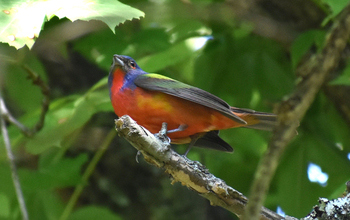Multimedia Gallery
Painted buntings breed in US during summer
An adult male painted bunting. Painted buntings breed primarily in the United States during the summer, then migrate to Mexico, Central America, southern Florida and the Caribbean over the winter.
More about this image
A team of researchers, led by Andrea Contina of the University of Oklahoma (OU), has identified the genetic structure of the painted bunting, a neotropical migratory songbird.
The team used microsatellite DNA and single nucleotide polymorphisms to develop high-resolution markers to differentiate between individual birds breeding in different Oklahoma populations and across the United States.
Through this research, Contina and his team can now differentiate between the eastern and western painted buntings, and can identify the species pattern of migration and population of origin.
"We combine molecular genetic research and conservation biology to differentiate between painted bunting populations and individual birds that migrate across several countries for breeding in the United States during the summer, then migrate to Central America for wintering where often they are captured and sold in the international avian pet market," said Contina, a National Science Foundation (NSF) National Research Traineeship postdoctoral fellow. "Genetic markers allow us to differentiate where the birds come from after they are sold."
Contina and the research team are collaborating to better understand why certain painted bunting populations are declining. The genetic research conducted by the team has international relevance and can be used in future investigative studies.
[Research supported in part by NSF grants CMMI 1014891, DEB 0946685 and DGE 1545261.]
Read more about this research in the OU news story Decoding the DNA of a songbird. (Date image taken: June 2018; date originally posted to NSF Multimedia Gallery: April 12, 2019)
Credit: Andrea Contina, University of Oklahoma, Oklahoma Biological Survey
Images and other media in the National Science Foundation Multimedia Gallery are available for use in print and electronic material by NSF employees, members of the media, university staff, teachers and the general public. All media in the gallery are intended for personal, educational and nonprofit/non-commercial use only.
Images credited to the National Science Foundation, a federal agency, are in the public domain. The images were created by employees of the United States Government as part of their official duties or prepared by contractors as "works for hire" for NSF. You may freely use NSF-credited images and, at your discretion, credit NSF with a "Courtesy: National Science Foundation" notation.
Additional information about general usage can be found in Conditions.
Also Available:
Download the high-resolution JPG version of the image. (3.2 MB)
Use your mouse to right-click (Mac users may need to Ctrl-click) the link above and choose the option that will save the file or target to your computer.



 All images in this series
All images in this series